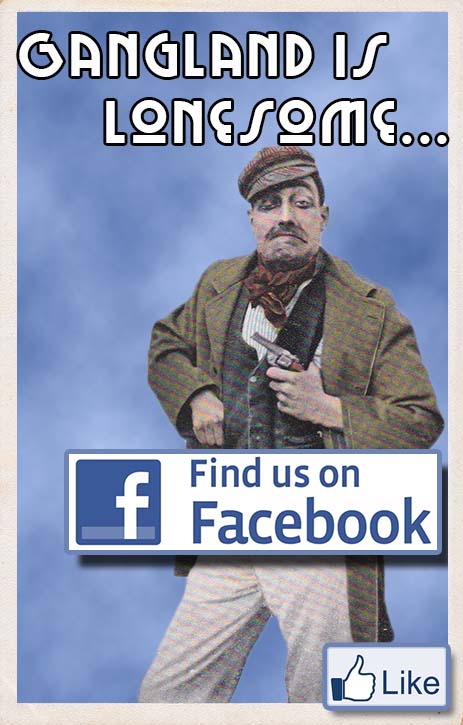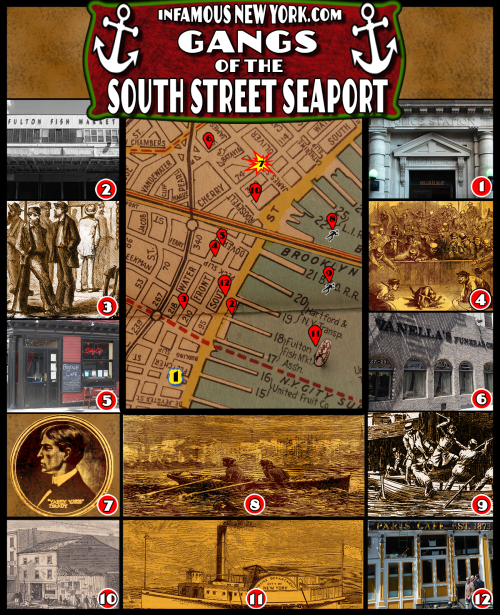
Click to enlarge map in a new window.
Murder, mayhem and river pirates are not among the listed tourist attractions at Manhattan’s South Street Seaport, but that’s exactly what a sightseer would have encountered during much of the district’s history.
Once a major port in the 1800s, this salty strip of land on the East River attracted merchantmen from around the globe for its deep waters and ice free docking, but with millions of dollars of cargo arriving daily came the dreaded specter of New York’s earliest organized crime syndicates—river pirates.
Today’s boutiques were once brothels and the gastro pubs rum holes. To walk these streets at night was to play a real-life game of Lets Make a Deal. Behind door number one: a whorehouse. Behind door number two: a dog-fighting pit. Behind door number three: shanghaiing, murder and death. Allow this South Street Seaport Walking tour to take you back to the days when river pirates and mobsters ruled South Street.
Gangs of the South Street Seaport Walking Tour Map
1 First Precinct: NYPD Museum
Location: 100 Old Slip, www.nycpolicemuseum.org
Status: Closed for Renovation
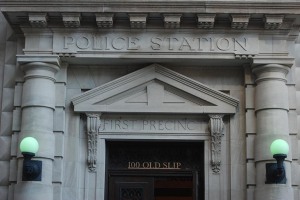
There’s probably no better place to start a tour of the criminal history of the South Street Seaport than the New York City Police Department museum. Sandwiched between looming skyscrapers, the landmarked 1909 neo-Renaissance First Precinct building represents the first modern police building in the U.S. and a must see for law enforcement buffs. Usually ringed with vintage NYPD vehicles parked curbside, the NYC Police Museum is under restoration because of flooding during Hurricane Sandy. When it reopens, guests will be treated to vintage uniforms, Willy Sutton’s lock picks, old mug shots, and the Tommy gun used to assassinate Frankie Yale.
2 Fulton Fish Market
Location: Pier 18 South Street
Status: Landmarked

It was the heart of the Seaport and the queen of South Street, an insular, self-regulated 188-year-old world populated by fishmongers and scoundrels and sea captains and Mafiosi. Now desolate and rusty, the battered, but landmarked, corrugated metal Tin Building on Pier 17 once stood as the district’s high temple of brine. If you get there early enough and squint into rising sun you might see them, the ghosts of the fish men who toiled from 1822 to 2005 in their blood spattered aprons under the predatory gaze of the gangs of New York.
The Mafia arrived in 1919, when a twenty-year-old character exploded onto the scene. His name was Joseph Lanza, but his mafia co-workers called the 230-pound bulldozer “Socks” because of the knockout force in his meat hooks. With the help of his knuckles, the mobster organized the United Seafood Worker’s Union, Local 202, and a goon squad incorporated as the Fulton Market Watchmen and Patrol Association on behalf of Joe “The Boss” Massaria and later Lucky Luciano and Vito Genovese. Lanza died in 1968 amid the constant probes of both federal and state organized crime task forces.
The Romano twins, Carmine and Vincent, picked up where Socks left off, extending the reign of the Genovese crime family into the late 1990s. The Federal Government convicted the Romano’s for violations of the Taft-Hartley anti-monopoly act in 1981, which paved the way for Rudolph Giuliani to initiate a lawsuit that placed the Fish Market under Federal Custodianship. In 2005, the reek of fish and crime wafted from the Fulton Fish Market for the last time when the entire industry packed up for the Hunt’s Point in the Bronx.
3 Water Street
Location: Water Street
Most visitors who stroll over the uneven cobblestones of Water Street fail to realize that the social reformer Oliver Dryer once called this thoroughfare:
“…the wickedest block in the wickedest ward in the wickedest city in America…” –Oliver Dryer
By the mid-1800s, Sailors arrived daily on Water Street to booze and whore the night away, but the seamen were always one step away from death. Consisting of one block of bars, brothels, rat pits and gambling dens, Water Street existed as the nexus of waterfront crime—a place where pirates plotted their next score, fixed elections and wrapped the corpses of murdered sailors in chains for disposal. On Water Street violence was endemic. The dives and whorehouses and hellholes that lined this street had fitting names. There was Long Marry’s at No. 275 and Mother McBride’s at No. 340, but none were more infamous than Kit Burn’s Rat Pit.
4: Kit Burn’s Rat Pit
Location: 273 Water Street
Status: Landmarked
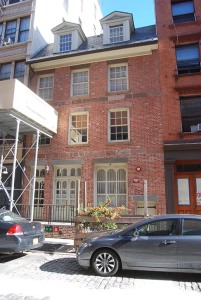
Now luxury apartments, 273 Water Street once represented the heart of Water Street’s “sporting culture. Officially named Sportsmen’s Hall, Kit Burn’s Rat Pit existed as New York City’s premier dog fighting and rat baiting venue. In the pit, a gaslight illuminated octagon, eighteen inches high, sixteen feet long, and eight feet wide, Kit pitted dogs against dogs and terriers against gigantic wharf rats in gladiatorial matches that would have made the Ancient Romans blush.
The pit was a family affair, and Kit ran business with his wife and daughter, Kitty, a dame well acquainted with the business end of a wooden club. For fun Kit brought in his son-in-law Jack the Rat, a character who would bit the head off a rat for a quarter a chomp. Henry Bergh, founder of the ASPCA, eventually put the bite on the Rat Pit and closed the establishment with the help of the NYPD. For a longer story on Kit Burn’s Rat Pit: https://infamousnewyork.com/2013/10/22/kit-burns-rat-pit/
5: The Bridge Café
Location: 279 Water Street Status: Closed for Renovation
http://bridgecafenyc.com
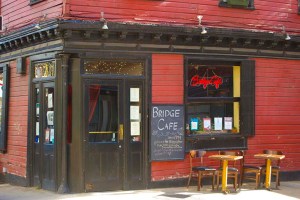
The Bride Café on Water Street was once known as the Hole-In-The-Wall Saloon, a vicious den of 19th century depravity.
Nearly destroyed by Hurricane Sandy, the Bridge Café exists as New York City’s last remaining pirate bar. Back in the 1870’s, the café was called the Hole-in-the-Wall Saloon. Owned and operated by Jack Perry and his wife, Mag Perry, the infamous Gallus Mag. A suffragette, before women’s suffrage became popular, Gallus earned her nickname from the unthinkable act of wearing trousers, rather than dresses, and holding them up with galluses or suspenders. When clients gave her trouble, Gallus often bit off their ears and dropped them in a pickling jar behind the bar. One-Armed Charley Monell later took over the bar and converted the upper floors into a brothel. By the 1900s, the Bridge Cafe became a hangout for the Yakey Yake Brady gang. For a longer story Gallus Mag the Bridge Café: https://infamousnewyork.com/2013/11/14/save-the-bridge-cafe-new-york-citys-last-pirate-bar/
6: Vanella’s Funeral Chapel
Location: 29 Madison Street Status: Open
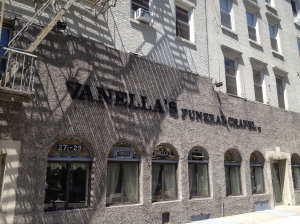
An original member of Johnny Torrio’s James Street Gang, Roxie Vanella (Namesake of Vanella’s funeral chapel) followed Torrio to Chicago, leaving a crime spree in his wake. After killing a corrupt police officer and beating the charges, Vanella returned to Corlears Hook in New York and opened this funeral chapel at 29 Madison Street. For the complete story on Roxie Vanella: https://infamousnewyork.com/tag/vanellas-funeral-chapel/
7: Yakey Yake Brady and the Rumble for Cherry Street
Location: Cherry Street
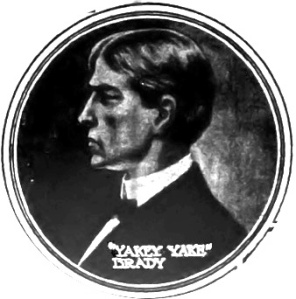
They came from the west with plunder on their minds and bucking revolvers in their hands. It was hard to say why in the spring of 1903 the thousand strong Monk Eastman mob turned their greedy paws on the slums of Cherry Street, but for John “Jake Yakey Yake” Brady it meant war.
Raised in the shadow of the Brooklyn Bridge, Yakey Yake carved out a fiefdom in the Irish slum known as The Gap in the northerly hollow of Cherry Street. A former jockey and barrel maker, Brady’s professions didn’t prevent him from mixing it up with the rowdies. Arrested dozens of times for scores of “accidental” and intentional shootings, Brady became the most feared man in Corlears Hook with a reputation so dreadful that when a longshoreman pressed assault charges on Yake; the dockworker hanged himself rather than face the hoodlum’s retribution.
When Monk Eastman came for Yake’s waterfront kingdom, the blood of gangsters turned the East River red. As the New York Sun put it:
“Under the bridge, revolver shots have echoed by twos and threes and by hundreds.”—The New York Sun, 1903
Because of the Monk’s superior numbers, Yake formed an alliance with Eastman’s perennial rival, Paul Kelly’s Five Points Gang, who had a nearby outpost on James Street garrisoned by Johnny Torrio and Roxy Vanella. To dam the tsunami of violence, the police ringed the district with undercover officers with orders to frisk and arrest any armed goons. The cops put Yakey Yake under such pressure that the gang leader wagered his barrel making firm on a card game and won a wagon team that he used to relocate to Jersey City, where he died in 1904.
8: The Sinking of Socco the Bracer
Location: Pier 27, Foot of Jackson Street
Flash, fire and smoke, lit up the night sky on May 29, 1873, when members of the Patsy Conroy mob exchanged gunfire with the harbor police at Jackson Street’s Pier. Earlier that evening, Joseph “Socko the Bracer” Gayle, Danny Manning, and Benny Woods hijacked a rowboat and rowed out in search of the ship, Margaret. Two skiff-borne harbor cops noticed the river pirates scampering up the ship’s anchor chain. Officers Musgrave and Kelly opened fire.
The rogues dove into their rowboat and pulled away into the darkness. A champion rower, Officer Musgrave gave chase while his partner scanned the horizon with a lantern, which was greeted by a pistol blast. The police answered with their six-shooters and traded broadsides with the thugs like a man-o’-war until a bullet tore through Socko. His companions pitched him overboard and the river bandit sunk to the bottom like a lead plated mackerel. The authorities apprehended Benny Woods the next day. Unfortunately, the Margaret sailed for China with the witnesses, ending any chance of a conviction.
9: Murder on the East River: The Saul and Howlett Story
Location: East River, Foot of Oliver Street
On the night of August 25, 1852, a pistol shot rang out from the Thomas Watson, a cargo ship anchored at the foot of Oliver Street. As Charles Baxter, the ship’s night watchman bled to death, two pirates rifled through the dying man’s clothing. The thieves then heard the rapping of a police nightstick against the cobble stone street, the signal for reinforcements in the days before police whistles.
A dozen lantern-carrying police officers sprinted to the scene, collaring William Saul and Nicholas Howlett, two river-borne rogues that Herbert Asbury incorrectly identified as leaders of the Daybreak Boys. (Former Chief of Police George Walling believed that the two men were the leaders of the Hook Gang) Whatever their affiliation, Saul and Howlett terrorized the waterfront for over a decade and the Chief credited the pair with twenty murders. The Baxter murder; however, would become one of the most sensational stories of the decade, signaling the end of the East River pirates. Saul and Howlett were found guilty of the murder were hanged in the Tomb’s courtyard on January 28, 1853. Bill “The Butcher” Poole attended the hanging to wish his river pirate friends farewell.
10: The Wickedest Man in America:
John Allen’s Dance Hall
Location: 304 Water Street
Status: Demolished
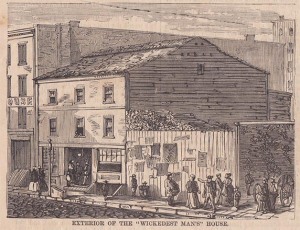
Priests, police and just about everyone else in New York City called John Van Allen the wickedest man in New York, and he reveled in it. In less than twenty years, Allen amassed over 113 arrests for running disorderly houses across the city, but his most infamous den was this now demolished Water Street dancehall.
The three-story bordello at 304 Water Street offered several dance floors, an orchestra pit and booths for sex serviced by Allen’s crew of twenty ladies of the night. A natural self-promoter, Allen set the tabloids aflame with his wacky antics even attracting the attention of Mark Twain who described Allen as, “a tall, plain, boney, fellow, with a good-natured look in his eye, a Water Street air all about him, and a touch of Irish in his face.” In reality, Allen probably wasn’t the wickedest man on Water Street by a long shot (his brother’s The. And Wes were far more wicked), but after his ceaseless campaigning for the title, the moniker stuck when the fishmonger transformed his whorehouse into New York City’s wackiest religious revival.
11 The NYPD Harbor Patrol
The murder of the ship watchman Charles Baxter by the infamous desperados Nicholas Howlett and William Saul alerted the public to waterfront crisis. Chief Walling commented on his battles with Saul and Howlett in his autobiography. He wrote,
“My investigations in this murder opened up to me a chapter in the annals of crime, of full horrors of which I never dreamed…human monsters prowled around our river fronts…who thought no more of the life of a man than that of a chicken.” Police Chief George Washington Walling
Following the Saul and Howlett case, the Police Department organized its first harbor patrol of several rowboats and took the war to the seas. The department purchased a steam ship named the Deer, which functioned as a fulltime floating station house. In 1858, the Metropolitan Police Force expanded the harbor unit to 57 men, six rowboats and the paddle wheel steamer, Senica. The men of the harbor police used to joke that the steamship was only fast when she was tied to the pier. The Senica was an abject failure that only made one arrest before burning to the waterline in 1880. Despite the failure of the flagship, the harbor force brought the pirates to their knees, pacifying the waters of the East River by the turn of the century and driving crime to the shores.
12 Meyer Hotel, The Paris Café and Project Underworld
Location: 119 South Street
Status: Landmarked
To complete your tour of the South Street Seaport, step into the Paris Café and have a drink at its original, hand-carved bar and ponder its history. Home to longshoremen, sea captains and mobsters, the Paris Café has served beer since 1873.
Constructed by alcohol merchant Henry Meyer, the Meyer Hotel and its Paris Café stood out as the poshest hotel and bar in the district. Thomas Edison, Annie Oakley, Buffalo Bill, Butch Cassidy, the Sundance Kid and Theodore Roosevelt all spent time in the building before beginning voyages to Europe and South America. When the passenger steamship lines moved their docks to the new Chelsea Piers terminal, the hotel fell into disrepair and the mafia took control.
By the 1930’s, Albert Anastasia and Louis Lepke Buckhaulter regularly met in the bar. Upstairs in the hotel, Socks Lanza orchestrated his fish empire. Socks controlled the Seaport with such impunity that the U.S. Navy came calling for the racketeer in the 1940s with an unusual proposition. They wanted him to help fight the Nazis.
Eventually with Lanza’s help, naval agents embedded themselves on the Atlantic fishing fleets to observe German submarines. Lucky Luciano was even contacted in Dannemora prison to help plan the invasion of Sicily.
For more information on Project Underworld: Allegiance between the Navy and the Mafia.
Read Full Post »
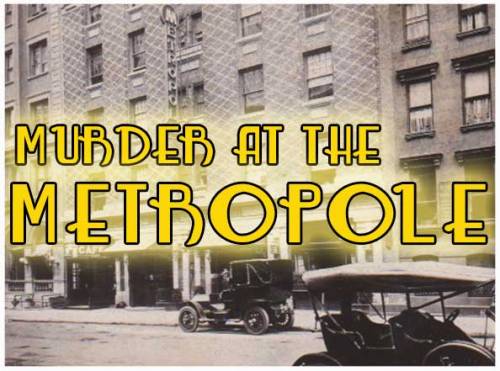
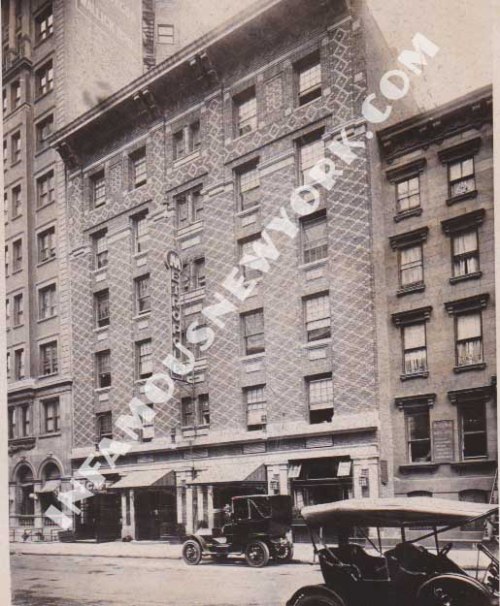
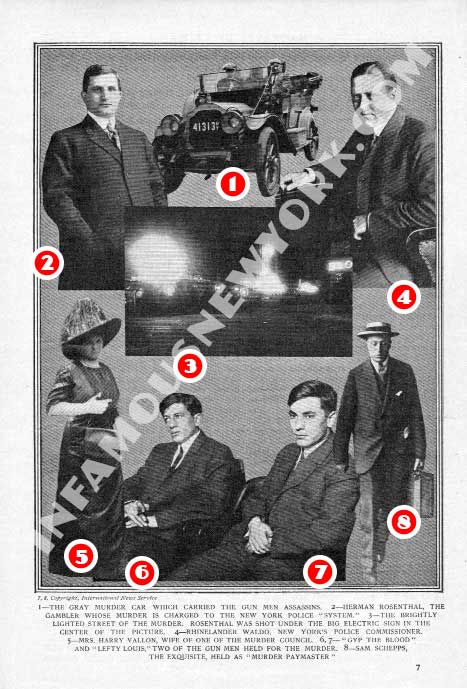
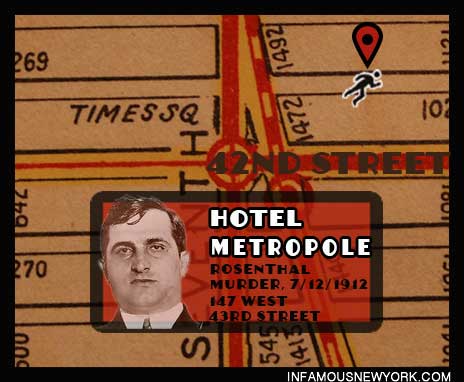

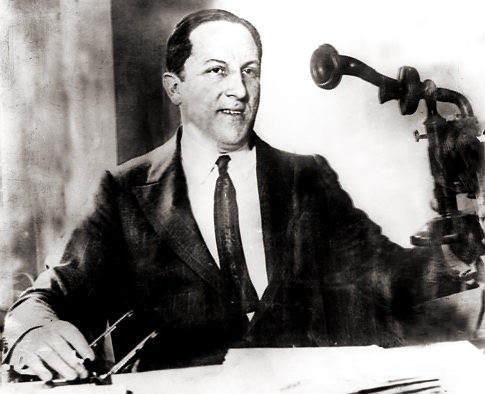
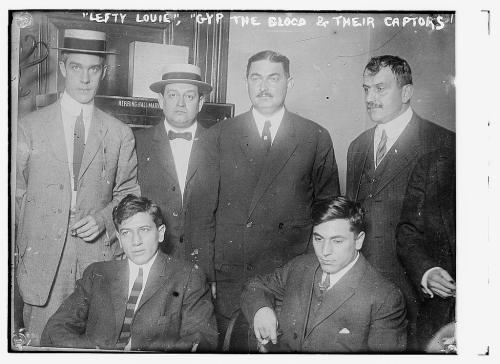
 NYPD officer Charles Becker was sentenced to death for the crime.
NYPD officer Charles Becker was sentenced to death for the crime.


















